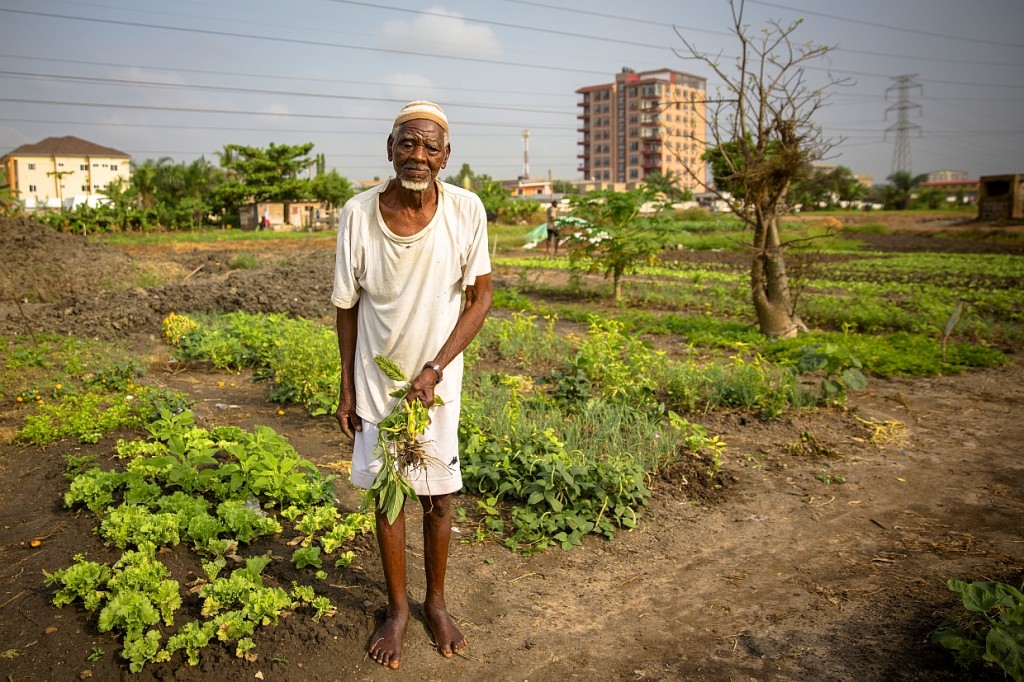Historically, many governments have either ignored urban agriculture or limited it for health and safety reasons.

But despite the lack of support, the sector has quietly gained traction – with an estimated 800 million people now involved in urban farming globally, generating as much as 20% of the world’s food production. Crop-raising in home gardens, vacant lots and open spaces under power lines, for example, help provide families with food and supplementary cash, while enabling them to become more resilient to climate change and other uncertainties. Furthermore, in many cities, most perishable vegetables found in markets are produced in inner-urban areas, contributing to the nutritious diets of the society at large.
Since 2005, the International Water Management Institute (IWMI), with support from the Resource Centres on Urban Agriculture and Food Security (RUAF Foundation), has led an effort to improve government support for urban agriculture in three cities in West Africa (Accra [Ghana], Freetown [Sierra Leone] and Ibadan [Nigeria]) and two cities in South Asia (Gampaha [Sri Lanka] and Magadi [India]) in two subsequent projects.
As a result, urban agriculture is now included in the city development plans of Accra and Freetown and provincial development plans in Gampaha, Sri Lanka. In both India and Ghana, urban agriculture is now being integrated into national agriculture policies and action plans, in efforts to enhance its potential to ensure food security.
Changes in some of the targeted urban areas have included adding agricultural extension officers, increasing training opportunities for farmers, improving the capacity of decision makers, allocation of funds for innovations and offering educational opportunities for the youth.
In a recent IWMI report on the topic, scientists attributed most of the successes to a process called Multi-stakeholder Policy Formulation and Action Planning (MPAP). The aim of this approach is to enable key players – government officials, farmers, nongovernmental organizations (NGOs) and others – to work together to influence long-term policy change.
But urban agriculture is complex – it is inexorably linked to the environment, health, climate change, waste management, recreation, sanitation, land use and employment. Building consensus is difficult, researchers say, because stakeholders usually have different visions based on their experiences, agendas and information. A key challenge is getting governments to recognize the importance of urban farming in improving livelihoods, and offer support for projects and training opportunities.
“Some perceive urban agriculture as critical to improving livelihoods, while others see it as a threat to public health due to food safety concerns because of unhygienic practices in the use of wastewater,” says Pay Drechsel, Leader for IWMI’s research theme on Water Quality, Health and Environment. “MPAP proved to be very useful in linking scientific evidence into a dialogue with stakeholders to address those kinds of concerns.”
The MPAP approach evolved gradually in the five cities over the course of several years, with an urban agriculture development plan devised for each city. IWMI initiated the dialogue with government departments that provide extension services, and other key stakeholders that have the power to influence policy in the country. With their support, other groups were invited to participate.
Researchers conducted an inventory of urban agriculture farming systems in each city, reviewed land-use policies, and the institutional environment. Multi-stakeholder forums were established to create the cities’ strategic agendas. Cities were asked to support pilot projects that would address local research questions and issues, with a specific focus on strengthening farmer organizations in urban areas and developing capacity for innovation in farming systems, microenterprise development (in production and processing) and marketing (value chain development).
Leadership of each multi-stakeholder forum and process was handed over to a local institution based on mutual agreement of the group. Those institutions were generally agriculture ministries, city agricultural departments or universities. In some cases, IWMI continued to facilitate the process for some time.
Those involved realized that there were significant regional differences in how best to achieve policy change.
In Ghana, for example, policy seminars and advocacy were most helpful at a local level while in Sri Lanka, the key step to reach out to the national policy was a change in the provincial policy, which set an example for others. In India, on the other hand, the project started on the ground but quickly learned to better target the national Planning Commission, so that recommendations for change had the required backing from the top.
One challenge researchers faced was a rapid turnover of government officials, who are key to public policy change. They also found that interest waned when MPAP training focused too much on theories rather than hands-on learning. The participatory approach was initially conceived as a training course of several days at a retreat, in order to get the participants away from their work schedules. But adjustments in the duration were made when it was found that learning declined after a few days. “It was important that our partner institutions realized how urban farming can help them achieve their policy goals (like improved nutrition, jobs, income or resilience to climate change) rather than becoming an extra agenda on its own,” said Olufunke Cofie, head of IWMI’s West Africa office, Accra, Ghana, and RUAF coordinator for Anglophone West Africa.
Field study visits were seen to be particularly enriching. Team members in Accra, Gampaha and Magadi were exposed to innovative agricultural practices, such as small-space and water-saving technologies, and the safe use of wastewater.
“The MPAP approach led to policy change in urban agriculture and allowed us to learn more about the pathway to move from research to outcomes,” says Priyanie Amerasinghe, Head, IWMI Hyderabad office, India, and Senior Researcher, Bio-Medical Sciences, and also RUAF coordinator for South Asia. “However, there is no one formula, some successes were enabled by individual champions or individual components of the overall MPAP process, so a ‘light version’ of the process might be the way to go.”
*

